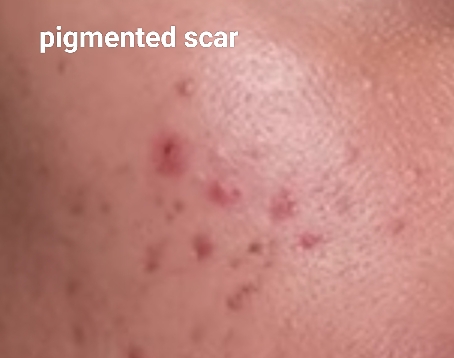Visitors have accessed this post 140 times.
Table of contents:
• Introduction
• Fungal Infections
• Types of Acne and Their Causes
• Understanding Scars
• Isotretinoin Cream
• Vitamin C Serum
• Conclusion
Introduction:
Acne can afflict various body parts, including the forehead, cheeks, jawline, chest, and upper back. Of particular concern is facial acne, as it is readily visible and can affect one’s self-esteem. Proper understanding of acne, fungal infections, and scars is crucial to manage these skin conditions effectively. Seeking professional medical advice and following prescribed treatments diligently can significantly improve outcomes. Remember, early intervention and consistent care play vital roles in achieving healthy, clear skin.
Fungal Infections:
Areas prone to heavy sweating, such as the underarms and thighs, provide an ideal environment for fungal growth. Using steroid creams without a doctor’s guidance can temporarily alleviate the infection but may fail to eliminate the underlying fungus. This could lead to the development of a resilient “super fungus,” rendering the condition difficult to treat. To ensure effective treatment, it is crucial to consult a dermatologist for proper medication and dosage. Adherence to the prescribed treatment plan is essential, and periodic check-ups are advised to monitor progress.
Types of Acne and Their Causes:
Acne arises from an imbalance in skin microbiomes. Several types of acne can manifest:
1. Whiteheads: These are non-inflammatory blemishes caused by excessive oil accumulation in pores, trapped by dead skin cells. Commonly found on the nose and forehead, they are distinguishable by the presence of white protrusions.
2. Blackheads: Clogged pores result in blackheads, where the dark color is caused by irregular reflection.
3. Papules: Small, red or pink bumps that are sensitive to touch, arising from excess oil secretion.
4. Pustules: Inflamed white bumps filled with pus, encircled by a pink ring. If untreated, they may lead to black spots and scarring.
5. Nodules and Cystic Acne: These severe forms of acne penetrate deeper into the skin, causing scars. Clogged pores and bacterial involvement contribute to their development.
Understanding Scars:
Pimples can damage the skin beneath, leaving scars even after they have healed.
Types of Scars and Treatments:
1. Genetic Scarring: Scarring can be hereditary, so self-treatment is not advisable. If a parent had scarring from childhood acne, prompt treatment for their child’s acne is essential.
2. Chickenpox Scars: Treatments for chickenpox scars include glycolic acid, tretinoin creams, micro-needling radiofrequency, fractional lasers, and derma rollers. These procedures stimulate collagen production to close pores and reduce scarring.
3. Pigmented Scar: Pigmented scars are a common skin issue that results in the deposition of pigments. One effective treatment for this type of scar is laser toning, which typically requires 2 to 3 sittings to achieve noticeable improvements. Additionally, several topical medications like glycolic acid, salicylic acid, lactic acid, tretinoin, vitamin C, and glutathione have shown promise in addressing pigmented scars.
4. Open Pores: Pores are the small openings on our skin’s surface that connect to sweat and oil glands. People with oily skin may naturally have open pores, which cannot be altered. However, if acne causes the pores to enlarge, treatment options are available. Micro-needling Radio Frequency (MNRF), fractional lasers, and tretinoin based creams are some effective treatments for minimizing open pores. Tretinoin creams stimulate collagen production around the pores, leading to their contraction, but these treatments require patience as they are long-term solutions.
pigmented scars can be effectively treated with laser toning and various topical medications. Open pores caused by acne can be managed through treatments like MNRF, fractional lasers, and tretinoin-based creams. Isotretinoin cream and vitamin C serum are valuable medicines, but they require proper medical supervision and understanding their limitations. Overall, prioritizing skincare and seeking professional advice can help prevent long-term skin issues and promote healthier, blemish-free skin.
Isotretinoin Cream:
Isotretinoin cream is a highly effective solution for treating both scars and acne. It operates by being processed through the liver, necessitating regular liver enzyme and cholesterol triglyceride check-ups as advised by the doctor. Women planning to conceive or those who are pregnant should wait for 2 to 3 months until the medicine is completely eliminated from the body or discontinue its use during pregnancy. Notably, isotretinoin cream can cause dryness of the lips and skin due to its reduction of oil gland size.
Vitamin C Serum:
Vitamin C serum is often used for its potential to enhance skin fairness and provide a slight glow. However, it is a relatively mild treatment, with effectiveness limited to around 20-30%. Consequently, it may not be sufficient for treating severe scars and acne. To make the most of its benefits, it is advisable to first reduce acne before incorporating vitamin C serum as part of a maintenance routine.
Conclusion:
Acne, especially when persistent, can be indicative of underlying conditions like Polycystic Ovary Syndrome (PCOS), leading to increased insulin and testosterone levels in affected individuals. It is crucial for individuals experiencing prolonged acne issues to consult a dermatologist and address any potential underlying causes. The mental pressure and stress experienced by school-going children and youngsters due to acne emphasize the importance of prevention rather than waiting for treatment after scarring occurs. Timely intervention is vital in treating acne promptly to minimize the risk of scarring.
